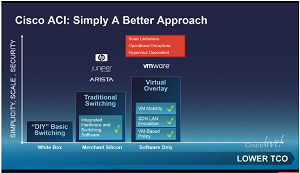News
Cisco Pushes Its Software-Defined Networking Vision
Company says it's delivering the SDN goods while slamming rivals at conference.
Cisco Systems Inc. might have gotten off to a rough start with the software-defined networking (SDN) bandwagon, but it climbed onboard and is starting to deliver the goods on its concept of the technology: the Application Centric Infrastructure (ACI).
Just before the start of its big Cisco Live conference underway now in San Francisco, the company said as much, announcing it was delivering on its vision with summer releases of key components such as an Application Policy Infrastructure Controller (APIC), an ACI fabric mode for its Nexus 9000 Series switches, UCS Director support for ACI and numerous other initiatives, including the new Cisco Services for ACI.
Not that Cisco positions ACI as an SDN technology. In fact, the term SDN was used exactly once in its aforementioned news release -- and that was just announcing that its Nexus 7000 Series switches were getting support for open source tools and standards for programmability and automation capabilities. Others continue to lump ACI in with SDN, though, to the extent the company earlier this year penned a blog post titled "Is ACI Really SDN? One Point of View to Clarify the Conversation." (The answer: You can think of ACI as SDN -- or as something different.)
That ambiguity might be explained by the fast-moving SDN phenomenon, which started out as something fairly simple -- having to do with decoupling the network control plane from the underlying forwarding/data plane and adding programmability through software -- and has morphed into a bunch of different approaches, philosophies and definitions, such as the one at Wikipedia and one at the Open Networking Foundation (ONF).
 [Click on image for larger view.]
Cisco's "Better Approach" to SDN
[Click on image for larger view.]
Cisco's "Better Approach" to SDN
(source: Cisco Systems Inc.)
Cisco embraced the SDN movement, joining the ONF and touting its Open Network Environment (ONE), but more recently has positioned ACI as an improvement upon SDN.
That approach has put it at odds with other SDN players, notably its partner (and Cisco Live sponsor) VMware Inc., with which it has been trading salvoes back and forth in a war of words. And Cisco is getting some licks in against its "frenemy" during its conference.
For example, Cisco senior exec Soni Jiandani singled out VMware as a counterpoint to her explanation of the benefits of ACI.
"We believe that ACI is simply a better approach," Jiandani said, explaining that Cisco has already been working with some 1,000 ACI technology customers, and it asked them why they chose ACI. She framed their answers against three alternative approaches: the "DIY" basic switching approach with white-box commodity hardware; the traditional switching approach using merchant silicon and integrated hardware and switching software, exemplified by vendors Juniper Networks and Arista; and the virtual overlay, software-only approach favored by VMware, with virtual machine (VM) mobility, SDN LAN emulation and VM-based policy.
"One option that many of our customers evaluated was the white-box model," Jiandani said. "And many of them said, 'it's not ready for prime time.' The second alternative that many of our customers were evaluating were merchant-only alternatives. The key point there was: 'I'm stuck with a box-by-box model. How is this any different? And how is this moving me any closer to a cloud experience?' "
She then moved on to the third alternative, championed by VMware.
"Some of our customers even went down the path of looking at software-only overlay models coming from leading companies like VMware, where they were promised technologies that will allow VM-mobility across a network," Jiandani said. "They were promised VM-based policies, and they were promised an SDN that looked like ATM line emulation, emulating one network on top of another network. Very quickly, the realization was, 'this technology has scale limitations. In a world of 10,000 virtual machines, if I have to discover all the endpoints, I have to deal with a lot of multicast storms across this network.' "
Imagine the scaling problems if the network comprised 20,000 or even 100,000 VMs, she said.
"I don't have a network anymore," Jiandani said. "I have a bunch of multicast traffic going around here, with a lot of latency and a lot of irrelevant traffic just to discover the endpoints. Now that I have discovered the endpoints and have a more optimized stack, you're asking me to go and upgrade all my endpoints? How disruptive is that?
"So it very quickly came to the realization that this technology is not ready for production," she continued. "It is not going to scale in a production environment."
In contrast, the ACI -- or systems -- approach offered customers choices by leveraging the power of innovation in ASICS hardware and software. Customers could choose what hypervisor and operational models to use, she said, with built-in security. Customers didn't "have to upgrade every endpoint to build a scalable network," Jiandani said. "One that is application-centric. One that can support a policy model. One that can accommodate deep telemetry, and one that is easy to troubleshoot and diagnose from a central location."
Jiandani will likely have more to say during today's technology trend keynote on ACI, "Fast Track to Fast IT: Cisco's Application Centric Infrastructure."
That presentation, Cisco said, will explain that SDN "holds the promise to transform IT operations across datacenter, access, wide-area networks (WANs) and the cloud. Cisco's approach to SDN, [ACI], takes SDN a step further to provide an architectural framework to address these operational challenges and more."
About the Author
David Ramel is an editor and writer at Converge 360.